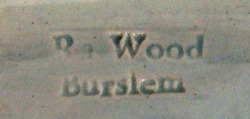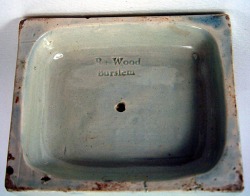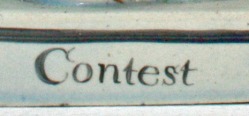Features Found on Ralph Wood Figures
Mark

Rarely, Ralph Wood enamel-painted figures are impressed "Ra. Wood Burslem". Ralph Wood also used the mark "R. WOOD" but that mark has not been recorded on enamel-painted figures. An impressed letter W has been observed on some Ralph Wood enamel figures, the W seemingly indicating WOOD.
Impressed Number

Numbers are sometimes impressed, usually on the rear side of the base. These are presumed to be mold numbers. But the problem is that the same number may occur on very different figures, and different numbers can occur on identical figure forms. Also, identical figure forms may occur numbered and unnumbered. Where the misnumberings errors or do they refer to something other than the mold? The purpose of the numbers remains a mystery. However, the presence of a number, along with other RW characteristics, is a strong RW identifier. Caution is justified because Enoch Wood also used impressed numbers on some figures.
David Tulk of Madelena suggests the impressed numbers are introduction sequence numbers. He writes
“Mold numbers they are not. One number appears on several different molds. Palette numbers they are not, nor artist numbers. The apparent progression in style however - jerky, but a progression nonetheless - doubtless mirroring developments in the tastes and fashions of the period - might support the notion that the sequence of numbers is chronological. Starting out with traditional style figures (1,2,9), it would seem the range was periodically enlivened with the introduction of new subjects (20 onwards) to maintain appeal. A more homely style becomes apparent in the choice of some subjects introduced later (50, 89, 90, 133, 134, 153, 154). Towards the end of the sequence are some that could be described as true to life naturalistic figures (150, 153, 154, 164, 166). My suggestion is that they are introduction sequence numbers. Most likely used when production first started it is anyone’s guess as to why they were abandoned in later years.”
David Tulk of Madelena suggests the impressed numbers are introduction sequence numbers. He writes
“Mold numbers they are not. One number appears on several different molds. Palette numbers they are not, nor artist numbers. The apparent progression in style however - jerky, but a progression nonetheless - doubtless mirroring developments in the tastes and fashions of the period - might support the notion that the sequence of numbers is chronological. Starting out with traditional style figures (1,2,9), it would seem the range was periodically enlivened with the introduction of new subjects (20 onwards) to maintain appeal. A more homely style becomes apparent in the choice of some subjects introduced later (50, 89, 90, 133, 134, 153, 154). Towards the end of the sequence are some that could be described as true to life naturalistic figures (150, 153, 154, 164, 166). My suggestion is that they are introduction sequence numbers. Most likely used when production first started it is anyone’s guess as to why they were abandoned in later years.”
Lines around the Base

Base showing line on sides but not rear
The painted line frequently decorating the base extends around three sides of the base only. There is no line on the rear of the base. This only occurs on figures that have RW characteristics.
Bases

Rectangular bases usually, but not always, have gently rounded internal corners.
Script
Titling, when present, is in one of four distinctive hands.
- Small fine hand, almost always painted in red.
- Large bold hand, painted in black.
- Large bold hand, almost always painted in black italics.
- Small fine hand, all uppercase, stylistically related to 1. This is the rarest form of titling.
Base Mounds
The mound atop the base is often painted in a distinctive palette. Three color palettes prevail:
- A rainbow-effect polychrome palette comprising shades of pink, blue, green, and brown. This palette is found on figures titled in a fine hand, painted red. The enameling on the figures tends to be delicate in pretty colors that complement the base.
2. A delicate pale green/brown palette, thinly applied. This palette occurs most commonly on figures titled in a fine hand.
3. A muddy green/brown palette. Figures with this base mound typically are decorated in a more somber palette. Titles, when present, are in a large hand.
Bocage
Bocages, when present comprise distinctive leaflets arranges in twos, threes, or fours. The three-arrangement usually occurs on figures decorated in the small red hand, while the four leaf arrangement is usually found on figures titled in a large hand.
Flowers are the simplest of round forms with no attention to petal form. Applied to the bocage on stalks, they are usually arranged in clusters of three.
Flowers are the simplest of round forms with no attention to petal form. Applied to the bocage on stalks, they are usually arranged in clusters of three.











